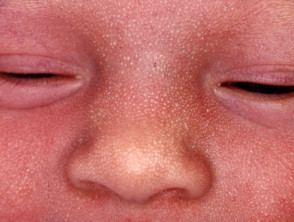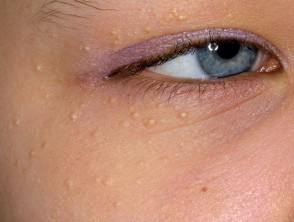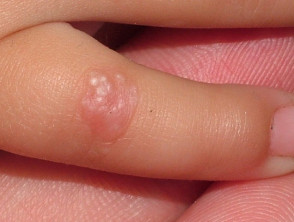What is a milium?
A milium is a small cyst containing keratin (the skin protein); they are usually multiple and are then known as milia. These harmless cysts present as tiny pearly-white bumps just under the surface of the skin.
What are the clinical features of milia?
Milia are common in all ages and both sexes. They most often arise on the face and are particularly prominent on the eyelids and cheeks, but they may occur elsewhere.
There are various kinds of milia.
Neonatal milia
- Affect 40–50% of newborn babies
- Few to numerous lesions
- Often seen on the nose, but may also arise inside the mouth on the mucosa (Epstein pearls) or palate (Bohn nodules) or more widely on the scalp, face and upper trunk
- Heal spontaneously within a few weeks of birth.
Primary milia in children and adults
- Found around eyelids, cheeks, forehead and genitalia.
- In young children, a row of milia may appear along the nasal crease.
- May clear in a few weeks or persist for months or longer.
Juvenile milia
- Associated with Rombo syndrome, basal cell naevus syndrome, Bazex-Dupre-Christol syndrome, pachyonychia congenita, Gardner syndrome and other genetic disorders
- May be congenital (present at birth) or appear later in life.
Milia in childhood
Milia en plaque
- Multiple milia appear on within an inflamed plaque up to several centimetres in diameter.
- Usually found on an eyelid, behind the ear, on a cheek or jaw.
- Affect children and adults, especially middle-aged women.
- Sometimes associated with another skin disease including pseudoxanthoma elasticum, discoid lupus erythematosus, lichen planus.
Multiple eruptive milia
- Crops of numerous milia appear over a few weeks to months.
- Lesions may be asymptomatic or itchy.
- Most often affect the face, upper arms and upper trunk.
Traumatic milia
- Occur at the site of injury as the skin heals.
- Arise from eccrine sweat ducts.
- Examples include thermal burns, dermabrasion, blistering rashes such as bullous pemphigoid.Often seen on the back of hands and fingers in porphyria cutanea tarda, and on the vulva in lichen sclerosus (see Vulval cysts).
- A milia-like calcified nodule may develop after neonatal heel stick blood test.
Milia associated with drugs
- May rarely follow the use of topical medication, such as phenols, hydroquinone, 5-fluorouracil cream, and a corticosteroid.
How are milia diagnosed?
Milia have a characteristic appearance. However, on occasion, a skin biopsy may be performed. This shows a small epidermoid cyst coming from a vellus hair follicle.
Milia should be distinguished from other types of cyst, comedones, xanthelasma and syringomas. Colloid milia are golden coloured bumps on cheeks and temples associated with excessive exposure to sunlight.
They should also be distinguished from milia-like cysts noted on dermoscopy in seborrhoeic keratoses, papillomatous moles and some basal cell carcinomas.
What is the treatment of milia?
Milia do not need to be treated unless they are a cause for concern for the patient. They often clear up by themselves within a few months. Where possible, further trauma should be minimised to reduce the development of new lesions.
- The lesion may be de-roofed using a sterile needle or blade and the contents squeezed or pricked out.
- They may be destroyed using diathermy and curettage, or cryotherapy.
- For widespread lesions, topical retinoids may be helpful.
- Chemical peels, dermabrasion and laser ablation have been reported to be effective when used for very extensive milia.
- Milia en plaque may improve with minocycline (a tetracycline antibiotic).


